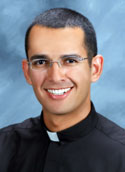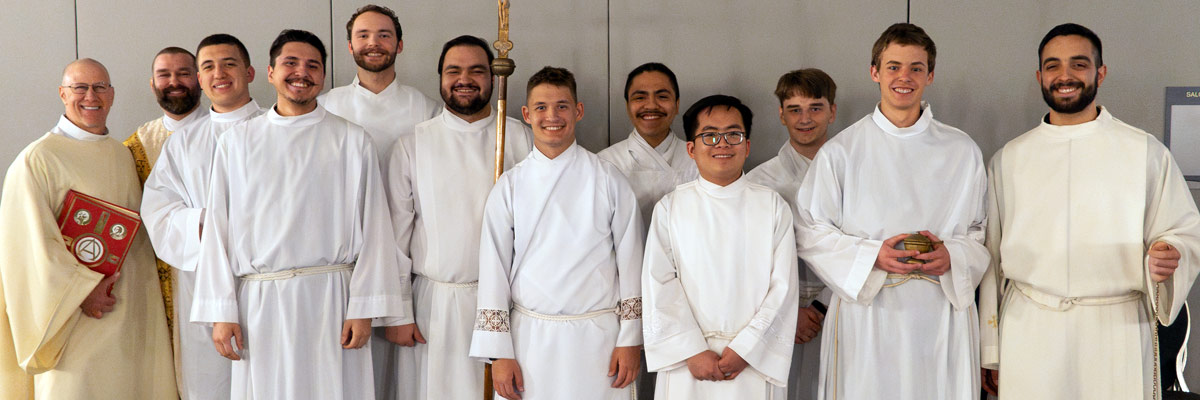Official Website of the
Catholic Diocese of Little Rock
Letters from Seminary
Priest's life must be work of art in world
Published: April 23, 2011
By Mauricio Carrasco
Diocesan Seminarian
“How beautiful upon the mountains are the feet of him who brings glad tidings, announcing peace, bearing good news, announcing salvation and saying to Zion, ‘Your God is King!’” (Isaiah 52:7)
 There was a brief time in my life when I felt toward priesthood very much like I felt toward Shakespeare. I felt I owed both some respect, and I knew that to openly dislike either would be to declare myself a fool. However, I didn’t really understand the priesthood or Shakespeare, and whatever people found enjoyable in them was beyond me.
There was a brief time in my life when I felt toward priesthood very much like I felt toward Shakespeare. I felt I owed both some respect, and I knew that to openly dislike either would be to declare myself a fool. However, I didn’t really understand the priesthood or Shakespeare, and whatever people found enjoyable in them was beyond me.
There was another brief period, after the early outbreak of abuse scandals in the U.S., when I wondered if priesthood was nothing but a joke. I just didn’t get it. How could priests do such things? A lot has happened since then, and my understanding of both priesthood and Shakespeare has changed.
It’s not that reading Shakespeare comes easily to me now, but seminary has helped me foster a love for literature and for art in general. I am learning to see how art helps us discover the world anew.
As my Old Testament professor says, an artist allows us to see what is familiar in a different light. The prophets, in this sense, were true artists. Isaiah, for example, was able to help the people of Israel experience their God anew.
Great works of art, like the books of the prophets or a Shakespearean play, have the capacity to make us say, “Wow! I had never realized that. Even a joke can be considered art, insofar as it relies on word play or irony to make us see something in a new way, a particularly humorous way.
In January, I had the opportunity to go to New York City for a cultural festival. I attended a conference on Chopin, viewed an exhibit on Flannery O’Connor, visited the Metropolitan Museum of Art and saw the performance of “The Tidings Brought to Mary,” a play by the French playwright Paul Claudel.
Yet, the most insightful words from that trip came from whom I least expected — a young lady named Samantha. She is discerning religious life and currently belongs to a community that serves the poor of New York City. She is a good friend of my brother seminarian Chris.
One night, as we stepped out of the conference center onto 34th Street, Samantha, Chris and I got to talking. I remember being particularly tired of all the hustle and bustle of the city, and I asked Samantha, “How do you do it?” Don’t you get tired of living with so many people?”
She shrugged her shoulders, smiled and then said, “It’s great! So many souls to save, and all of them here.” Thrown off guard, I said something like, “Hmm, I guess I didn’t think about that.” That helped me see her situation and mine in a new way.
I am utterly convinced that the priest must be somewhat like Shakespeare, Isaiah and Samantha if he is to help others see the world anew. He must be an artist in his own way, and his life must stand as a work of art. People should hopefully come to see God and the world in a new light by witnessing the life of a priest.
I would like to encourage all, especially those entering the Church this Easter, to read the “Story of a Soul,” St. Therese of Lisieux’s autobiography; read “St. Francis of Assisi” by G.K. Chesterton; and read the story of Blessed Miguel Pro. All of them were true artists and to discover their lives is to come to see God anew.
Don’t be surprised to find out that they were all very joyful. One can easily come to see them as the sort of people who knew how to have a good laugh. God knows, perhaps to them their vocation really was a joke; only they get it, and we often don’t.
This series was written when seminarian Mauricio Carrasco was studying for the priesthood and chronicles the joys and struggles of his formation along the way. Today, Father Mauricio Carrasco is a priest serving the people of the Diocese of Little Rock. The series was originally published in Arkansas Catholic. Copyright Diocese of Little Rock. All rights reserved. It may be copied or redistributed with acknowledgement and permission of the publisher.




